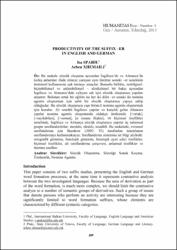| dc.contributor.author | Spahıu, Isa | |
| dc.contributor.author | Xhemaılı, Arben | |
| dc.date.accessioned | 2017-06-02T13:30:56Z | |
| dc.date.available | 2017-06-02T13:30:56Z | |
| dc.date.issued | 2013 | |
| dc.identifier.uri | https://hdl.handle.net/20.500.11776/1294 | |
| dc.description.abstract | Bu makale sözcük oluşumu açısından İngilizce?de ve Almanca?da özdeş anlamları ifade etmeye yarayan aynı türetme soneki –er sonekinin üretimsel kullanımına ışık tutmayı amaçlar. Bununla birlikte, sesbilgiselbiçimbilimsel ve anlambilimsel – sözdizimsel bir bakış açısından İngilizce ve Almanca?daki eyleyen adı için sözcük oluşturucu yapıları araştırır. Bulunan ortak bir eğilim ise her iki dilin –er soneki ile nomina agentis oluşturmak için sabit bir sözcük oluşturucu yapıya sahip olduğudur. Bu sözcük oluşturucu yapı birincil nomina agentis oluşturmak için kurulur. -Er sonekli İngilizce yapılar ve karşılık gelen Almanca yapılar nomina agentis oluşumunda oldukça üretkendir. [+ortak], [+sayılabilen], [+somut], [? insana ilişkin], vb biçimsel özellikler temelinde, İngilizce ve Almanca sözcük oluşturucu yapılar üç anlamsal grupta sınıflandırılırlar: mesleki, sürekli, tesadüfi. Bu makalede, evrensel sınıflandırma için Baeskow (2002: 52) tarafından tanımlanan sınıflandırmayı kullanmaktayız. Sınıflandırma sistemine ait bilgi şöyledir: ortografik gösterim, fonolojik gösterim, fonolojik ayırt edici özellikler, biçimsel özellikler, alt sınıflandırma çerçevesi, anlamsal özellikler ve türetme sınıfları. | en_US |
| dc.description.abstract | The paper aims to shed some light on the productive use of the suffix -er in English and German, which, from the word-formation point of view, is the same derivation suffix to express the identical meanings. However the article investigates word-formative patterns for nomina agentis in English and German from a phonological-morphological and semantic-syntactical point of view. One common tendency found is that both languages have a stable word-formative pattern for building nomina agentis with suffix -er. This word-formative pattern is constructed to form primary nomina agentis. The English patterns with the suffix -er and the corresponding German patterns are highly productive in the formation of nomina agentis. On the basis of the formal features [+common], [+count], [+concrete], [? human], etc., the English and German word-formative patterns are classified in three semantic groups: professional, habitual and occasional. In this paper, for the global classification we use the classification defined by Baeskow (2002: 52), classifying system information as follows: orthographic representation, phonological representation, phonological distinctive features, formal features, sub categorization frame, semantic features and derivation classes. | en_US |
| dc.language.iso | eng | en_US |
| dc.publisher | Namık Kemal Üniversitesi, Fen-Edebiyat Fakültesi | en_US |
| dc.rights | info:eu-repo/semantics/openAccess | en_US |
| dc.subject | Sözcük Oluşturma | en_US |
| dc.subject | Sözcüğe Sonek Koyma | en_US |
| dc.subject | Üretkenlik | en_US |
| dc.subject | Nomina Agentis | en_US |
| dc.subject | Word Formation | en_US |
| dc.subject | Suffixation | en_US |
| dc.subject | Productivity | en_US |
| dc.subject | Nomina Agentis | en_US |
| dc.title | PRODUCTIVITY OF THE SUFFIX –ER IN ENGLISH AND GERMAN | en_US |
| dc.type | article | en_US |
| dc.relation.ispartof | HUMANITAS - Uluslararası Sosyal Bilimler Dergisi | en_US |
| dc.department | Tekirdağ Namık Kemal Üniversitesi Dergileri | en_US |
| dc.identifier.volume | 1 | en_US |
| dc.identifier.issue | 2 | en_US |
| dc.identifier.startpage | 209 | en_US |
| dc.identifier.endpage | 217 | en_US |
| dc.relation.publicationcategory | Makale - Ulusal Hakemli Dergi - Kurum Öğretim Elemanı | en_US |



















